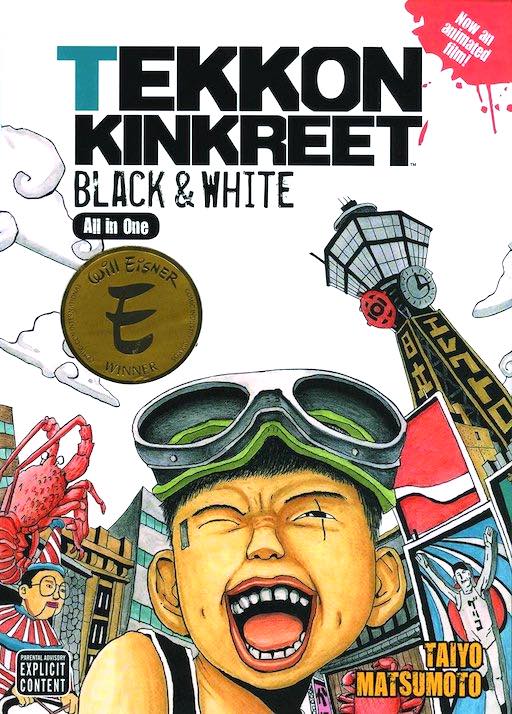Tekkonkinkreet: Black And White
Foreword to the all-in-one edition published by VIZ Media
screenwriter Anthony Weintraub and director Michael Arias
March 5, 2007
Taiyō Matsumoto’s Tekkonkinkreet was turned into an animated film in 2006. Director Michael Arias and screenwriter Anthony Weintraub lovingly and painstakingly worked to keep the movie as faithful to the graphic novel as possible. The following are excerpts from a discussion they had in February 2007 about the manga and anime.
Anthony Weintraub How did you first discover Tekkonkinkreet and what was your initial reaction? Overall impression?
Michael Arias I was back in Tokyo after a couple of years in the States and my roommate at the time recommended it. It was around ’95—a weird time in Tokyo, just after the Kobe quakes, right in the midst of the Aum Shinrikyo gas attacks. Helicopters flying over the city, police patrolling the streets in force. And my friend and I, both unemployed at the time, were spending hours and hours sitting on his balcony watching the streets below. And that’s how I first started reading Tekkon.
All of that weird pre-apocalyptic tension—two guys sitting up high and looking down on the streets—that felt so much like the manga’s first panels of Black and White, crouched on top of telephone poles, looking down, guarding the streets.
Also, right in our neighborhood, there was an enormous construction project. The city had finally decided to demolish the old Doujunkai apartments in Daikanyama. An entire neighborhood—a beautiful little gem of a city, with tons of street life, artists ensconced there, covered with ivy—got leveled as we watched and then gradually transformed into a skyrise... Anyways, seeing a big chunk of my world evolve like that was very influential in the end.
...I remember my friend telling me as he handed Tekkonkinkreet to me, “it’s going to make you cry” and not really believing him.
But there it was, on the page. And I definitely cried a lot those first few reads. There are still scenes in there that get my juices owing... Never thought a comic book could do that to me.
AW Of course I got the manga from you when you were thinking of getting a screenplay written, and I was blown away by it. Somehow those two guys felt so real, you’re right. They are so distant from the world that was caving in around them, yet so passionate about it. I couldn’t believe the look of the manga—not only the way the characters were drawn but also the way the story was designed. To me it looked like the best of Japanese manga illustration meets the innovative design of the best graphic novels. But it was the story that got me—these two boys who are thrust into this terrible situation. I could really sympathize with their plight, and I was also amazed at how the story develops. It made sense to me as a movie, and yet I knew it was going to be an amazing challenge to try to take a story which was originally developed over three volumes and figure out a way to tell that story in a feature-length lm. This is an incredible human story set in a futuristic, impersonal environment. Taiyō Matsumoto’s true talent is that he bounces one off the other so poetically.
⁂
AW Over time, especially with working on the film, did your impressions of the story change?
MA It’s interesting—my notions of its “deeper meaning” flip-flopped several times while making the movie... But I thought when I was starting out that this was really White’s story, that showing White as some kind of human ideal, even telling the story through his eyes to a certain extent, would be most powerful. At the very least I thought I’d be balancing White and Black—emphasizing the whole yin-yang (Black-White) theme that’s there.
But then as I got deeper into it I really started identifying with Black. I got to the point where the Black-White duality seemed much less about White vs. Black than about one regular guy, Black, and a battle being fought for control of his soul, a battle between White and the Minotaur. That I saw being paralleled in the story of Kimura sandwiched between Suzuki and Snake.
But it’s funny, Tekkon, the manga I mean, is like that. I’ve read it hundreds of times and every time it’s a different story.
I think that’s one of its strengths—that instead of giving answers it just as often is asking a question: “What do you believe in?” And of course a reader’s answer to that is entirely up to where he is in life at that point.
AW Yeah, I agree... I guess the one thing I would say is that in some way the deeper and deeper you get into the manga, the more your understanding changes, just like any great work of art. On first read it feels like a great actioner, two kids taking on the gangsters. The more you explore, the more you realize this is much more about them, about the crisis that is fomented by the physical events. So I guess over the time I was adapting it I really grew much closer to Black and White’s arcs—how they grow and change over the course of the book—and wanted so badly to do that story justice.
⁂
AW What was it like working with Taiyō Matsumoto?
MA Working with Taiyō has been thoroughly enjoyable, though I didn’t see much of him, except socially, once the screenplay was complete. You and Taiyō and I have had some wonderful times over the last few years while making the movie and after completing it. He’s one of my best friends as you are. And I think he’s really happy with the way the movie turned out. He said it was like going to a class reunion and finding all his childhood friends (Black, White, Kimura, Rat, etc.) exactly as he remembered them. Of course he himself had aged ten years or so...
AW Yeah, Taiyō was a dream. I can vividly remember our first meeting—at a little Vietnamese place in Shimokitazawa Tokyo. He was not as I expected—of course I was so excited to meet him because I was such a fan. By that time I think I’d read a few of his other manga. I don’t know what I was expecting but here was this diminutive, incredibly shy, incredibly nice guy. Once we got to talking it was like being with an old friend. He was so generous, which I thought was amazing for a guy who was meeting the American screenwriter who was adapting his baby for the first time. He was always incredibly open from that minute on—sharing anecdotes about what inspired him to write Tekkon.
⁂
AW I’m wondering, how would you describe Treasure Town to the uninitiated?
MA In my very first meeting with Shinji Kimura, my art director, I described Treasure as the real “hero” of the movie. The screenplay is structured so that the development of the city is the story that ties everything together. So I wanted the city to be as rich and believable as possible, more than just window dressing, and more than just pictures behind the characters.
AW As you said, I always saw Treasure Town as that thing you remember from your past you just can’t let go of—that TV show, that cherry snow cone, whatever. These are the things that make you who you are really. Once they are gone, or once you have grown up, it’s futile to try to recreate them, or even find them again. Because they’ll never be the same. But for these characters, at least these two young boys whose very existence is so closely tied to the town, letting it be destroyed is akin to losing part of their souls. It’s alive for them, it’s not some remembered past.
MA True.
AW How I would describe the series to someone who had never seen the manga or the lm... I think I would talk about how deeply affecting the story is, and how important it is. I feel it’s really about preserving innocence inside us versus letting ourselves become bitter and angry. This story has a nice dose of Peter Pan in it, a ‘lost boys’ kind of quality. The core story is about how important it is to keep an innocent heart, to stay uncorrupted, which is impossible, of course, but a great ideal.
And it’s really these messages that live on, that make it universal.

Tekkonkinkreet All-in-one edition published by VIZ Media copyright © Taiyō Matsumoto and Shogakukan
